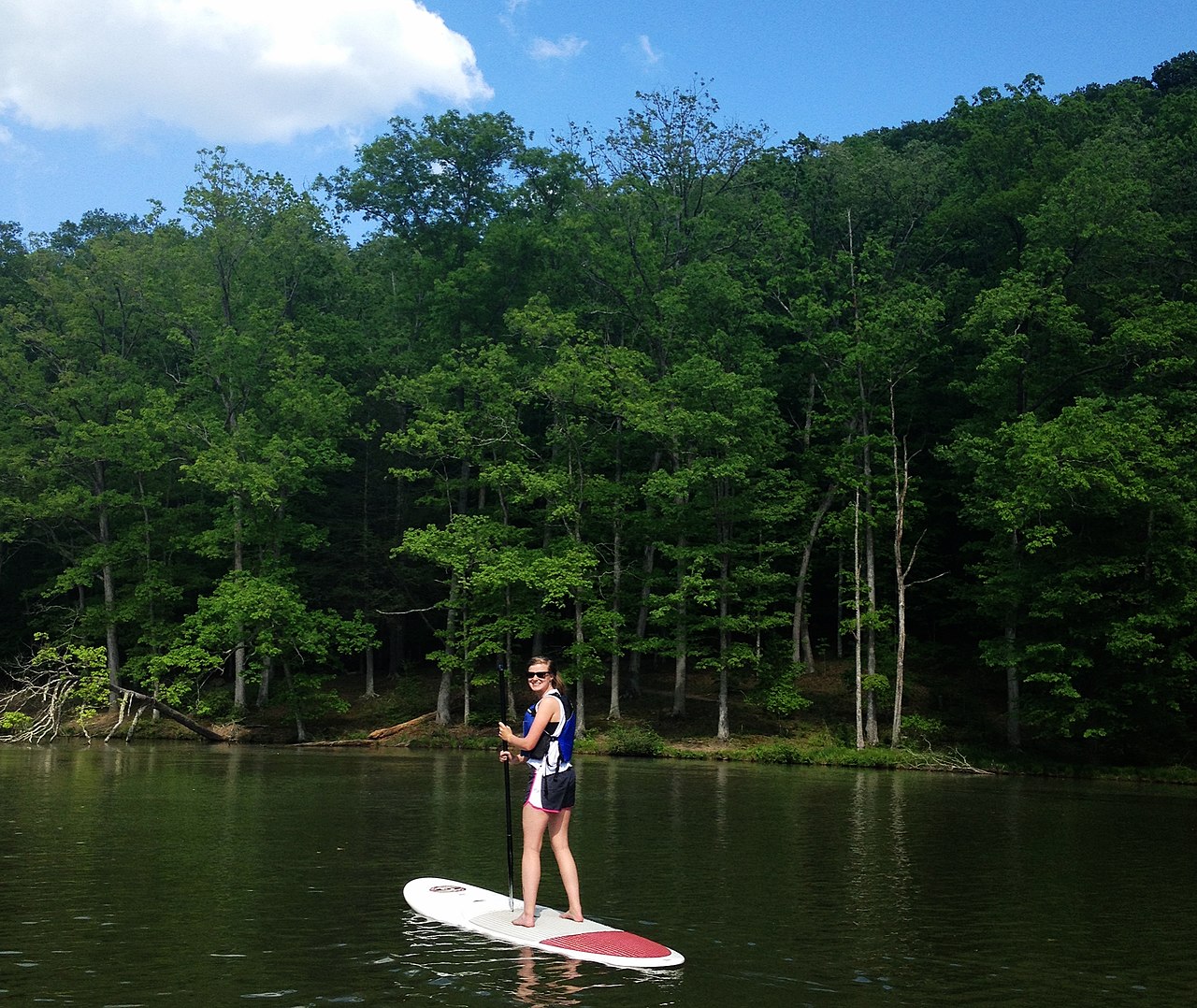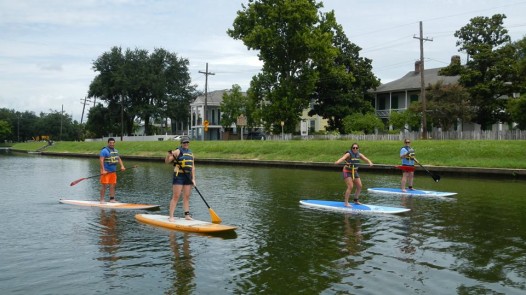Editor’s Note: The following series “Something Fishy” is a week-long series curated by Rosalind Kidwell as part of the Digital Research Internship Program in partnership with ViaNolaVie. The DRI Program is a Newcomb Insitute technology initiative for undergraduate students combining technology skillsets, feminist leadership, and the digital humanities.
An integral part of life in South Louisiana is our extensive aquatic life. Fish permeate New Orleans culture, whether they’re from the Gulf or a nearby Bayou, whether they’re on or off our plates. This collection of articles for “Something Fishy,” explores the importance of these creatures in the nearby area. Living in an area surrounded by water lends itself to unique pastimes like paddle boarding, though on your first attempt, you might feel like a fish out of water. This article was originally published on NolaVie on July 17, 2013.

It’s almost like we can walk on water…well, kind of. (Photo: Wiki Commons)
(Note: This is one in a series of articles on alternatives to traditional workout regimes. Aside from preventing boredom, it has been shown that varying one’s workouts improves results. Consult a doctor before starting any workout program. For more in the series, click here.)
On a recent spring vacation to Fort Walton Beach in Florida, local artist Rebecca Rebouche took up a friend’s offer to do some stand-up paddleboarding.
“If you have a good sense of balance, it’s a fast learn,” said Rebouche. “Of course, I also wasn’t afraid to fall in the water a few times.
Standup paddleboarding, or “SUPing” as some enthusiasts call it, is fairly self-explanatory — it’s done on what is basically a larger, extremely buoyant surfboard with a one-sided paddle, and a leash similar to those that surfers use to keep their boards attached.

Paddleboarding on Bayou St. John
“What I like is the sensation that you are standing on top of the water,” said Rebouche. “We also saw some beautiful sea life in the clear waters of the Gulf, like dolphins and sea turtles. That was pretty amazing. I can’t wait to get out and do it again.”
“It requires minimal gear,” said Jeff Lakey, owner and founder of NOLA Paddleboards. “It’s a very simplistic thing. You don’t have to rely on conditions. A lot of wind-driven sports need ideal conditions, whereas this doesn’t, which is perfect for here because you don’t have a lot of wind.”
Lakey, a New Orleans native who first encountered paddleboarding while working as a lifeguard in California after Hurricane Katrina, said Bayou St. John is one of the more popular SUPing spots in town. While having the advantage of being smack dab in the middle of the city, “even on a windy day it doesn’t have the surface area to really amp up with waves or chop,” said Lakey.
Lake Pontchartrain is also popular, Lakey said, but only for more experienced paddleboarders. “You just have to look at the conditions, and keep in shore or harbor areas. It’s a really great place to kind of escape the city and not see any buildings over the horizon.”
While providing a full-body workout, the sport, said Lakey, particularly works the shoulders, back, and core, as well as the heart. “It’s kind of what you make of it. You can take a nice leisurely pace or you can really kind of crank up your cadence and get a good cardio workout out of it.”
While it’s unclear how long people have been doing some form of paddleboarding, it really took off in Hawaii and California in the 1960s and 1970s, Lakey said. “A lot of the surf guys would use these to take pictures of tourists surfing and also they can kind of see the incoming waves, so there’s a lot of advantages for instructors of surfing to using them.”
But until recently, technology kept paddleboarding from expanding too far.
“These things used to weigh 60, 70 pounds for a wooden paddle board,” said Lakey, “whereas now with the material they’re using, they’re 30 pounds and you can carry these things a half a mile without stressing,”
Lakey said the boards at his store generally vary in price from about $800 to $1200. And upkeep is easy. “Just splash them with some fresh water if you take them out in salt water just to prevent faster fading,” he said.
In the last decade, the new, lighter boards have helped paddleboarding to extend into areas without ideal beaches, or “flatwater cities,” as Lakey called them.
“Now you can get that kind of surfing feel and get the benefits of just a good fun workout in flatwater places – lakes, rivers, pretty much everywhere. It’s picking up.”
For information on gear or lessons, visit www.nolapaddleboards.com.
Brian Friedman writes about New Orleans for NolaVie.
 NOLAbeings Multimedia artist Claire Bangser created NOLAbeings as a portrait-based story project that marries...
NOLAbeings Multimedia artist Claire Bangser created NOLAbeings as a portrait-based story project that marries...  Voodoo in New Orleans: Reviving history: New Orleans fortune telling This article takes a deep dive into the history of Voodoo in New Orleans, its hybridization with Catholicism, and its present-day place in the city's culture. The author visits fortune-tellers in the French Quarter, using their guidance as a tool for introspection rather than a deterministic predictor of the future. Through her experiences in New Orleans, the author feels a mystical connection to both the past and the future.
Voodoo in New Orleans: Reviving history: New Orleans fortune telling This article takes a deep dive into the history of Voodoo in New Orleans, its hybridization with Catholicism, and its present-day place in the city's culture. The author visits fortune-tellers in the French Quarter, using their guidance as a tool for introspection rather than a deterministic predictor of the future. Through her experiences in New Orleans, the author feels a mystical connection to both the past and the future. 